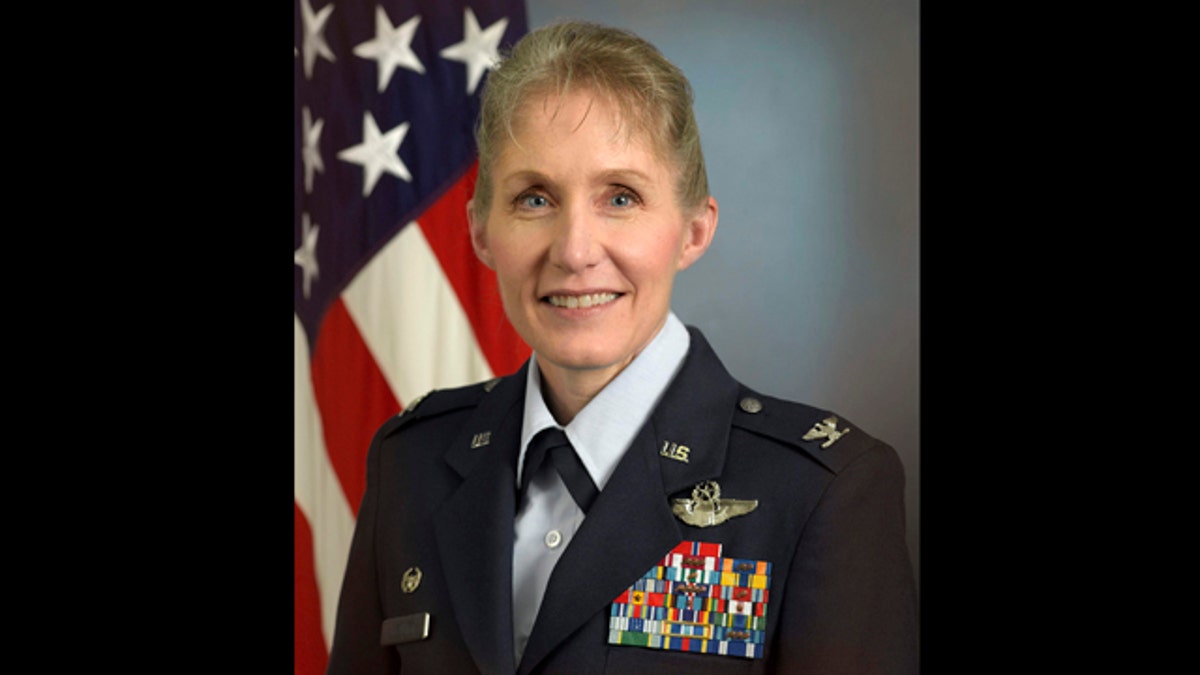
June 23, 2011: Photo released by the U.S. Air Force of Col. Jeannie Leavitt. (AP)
COLUMBIA, S.C. – The woman who became the Air Force's first female fighter pilot in 1993 is adding another first to her list of achievements. Col. Jeannie Leavitt has become the first woman to take command of an Air Force combat fighter wing Friday in North Carolina.
During her 20 years in the Air Force, Leavitt says she's familiar with being in its leading ranks of women, but believes she has earned her position through performance, not favoritism.
"It helped that once we started flying, people began to see that we were there because of our abilities and not our gender," Leavitt said in an exclusive telephone interview with The Associated Press. "I don't see it as a `first' sort of thing. I see it as an incredible opportunity, an incredible honor, to lead a unit with its history and heritage."
Leavitt has logged more than 2,500 hours in the F-15 Strike Eagle, including 300 hours flying in combat primarily in Iraq and Afghanistan.
The 45-year-old from St. Louis, Mo., takes over the 4th Fighter Wing at Seymour Johnson Air Force Base, one of only three units of F-15Es, the service's premier fighter jets. Leavitt will be in charge of the wing's 5,000 active duty men and women, with 12,000 civilians in the base population.
The seasoned pilot is married to another Air Force colonel and they have two children. She entered the Air Force in 1992 through ROTC after earning a degree in aerospace engineering at the University of Texas. Since then, Leavitt added four master's degrees to her educational credentials and a number of military medals, such as a Bronze Star.
With high scores in her undergraduate classes, Leavitt earned a place as the first woman tapped to enter training as a fighter pilot.
When Defense Secretary Les Aspin ordered the services to drop restrictions on women flying combat missions in 1993, she became the Air Force's first female fighter pilot. She went on to be the first female to graduate from its elite Air Force Weapons School, where she also became an instructor.
She takes command from Col. Patrick Doherty after serving one year in Washington, D.C., on a special assignment as an Air Force fellow with the Central Intelligence Agency. She has also served as a commander of a fighter squadron and deputy commander of an operations group at Bagram Air Base in Afghanistan.
"She's a great wingman," says her boss, Maj. Gen. Lawrence Wells, who flew with her in combat over Iraq. "She has everything she needs to be a great commander."
Wells, the two-star general who commands the 9th Air Force and who will preside over the change-of-command ceremony on Friday, said he thinks putting her in such a premier command slot "is overdue. It's just one more feather in her cap."
The general recalled that in one sortie over Iraq, Leavitt was the flight leader, while he flew in a support role in an F-16. The F-16s were flying for the first time with weapon capabilities that allowed them to seek out and attack enemy radar, paving the way for the F-15s to follow through and conduct airstrikes.
"I've flown with her, I know her capabilities," said Wells. "When you fly like that, you fly under intense pressure. It takes great personal strength."
Wells said Leavitt "has what it takes to lead a fighter wing, and she knows how to take care of her people. She knows how to take care of those flying in the cockpit, but also those on the ground who fix the airplanes and change the tires."
The general said only 6 percent of all Air Force officers make the rank of colonel, let alone hold a command position.
"It's a steep climb. For her to be where she is today, well, I think it sends a strong message," Wells said. "Because of what she has done, a lot of people will be able to follow behind her."

